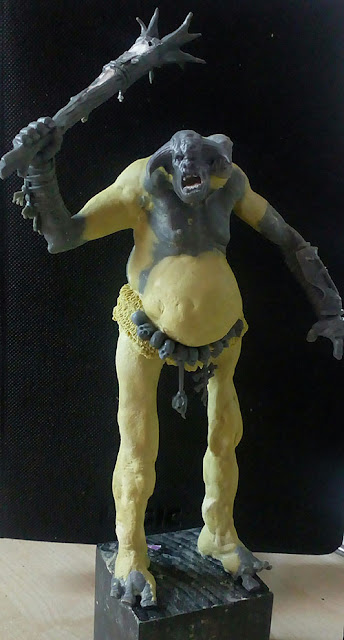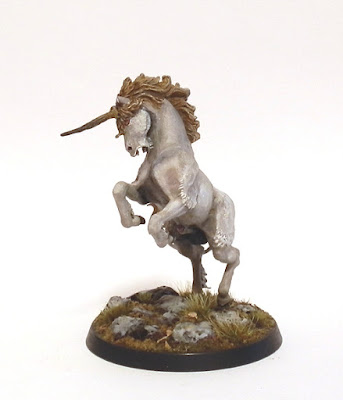Sir Pelial of Turm was on his way across the island Erebos, set on the quest to slay giants in the North. As he rode through a dark wood one morning, he met an Aelf. The Aelf said to Sir Pelial from under her hood, "Good morning, Sir Knight. What brings you to this here dark wood?"
"I am on a journey North to slay giants," replied Sir Pelial to the Aelf, and introduced himself. The Aelf did not return the courtesy, which is a behaviour Sir Pelial did not appreciate at all. She simply went on with her prying questions.
"So, you are a monster-slayer, too. Perhaps we could help each other out? I am on a quest myself, you see..." Sir Pelial only stared blankly at the Aelf. She continued, "I am in these woods to end the snake-king Basilisk and cut off his head. If you help me, I shall join you on your journey to find giants to slay. I have great skill with a bow, and I can shoot them in the eye to blind them."
"I have no time for snake-hunting, nameless Aelf. I must go on my way," said Sir Pelial finally, and lightly spurred his horse.
"But there is treasure in the snake-king's den! If you help me, I will let you have it," the Aelf exclaimed. Sir Pelial halted the nag and turned to the Aelf.
"Lead the way..."
The Aelf tracked the snake-king to the pit, where he had his home. A terrifying monster he was, with wings and talons of a rooster, and a green, scaly tail like a dragon. On his head he had a bright red comb, as a crown.
Sir Pelial readied his lance and shield, and the Aelf strung her bow. From the shadows of the trees she fired her first arrow at Basilisk's side. The monster crowed in pain, and, enraged, turned his sharp gleaming beak in the knight's direction. That is when the second arrow came. And Sir Pelial charged boldly at the monster, aiming the lance for its serpent heart.
When the snake-king Basilisk was dead, the Aelf took her sword and cut off his ugly red head, which she placed on a hook. "Indeed, you have great skill with a bow. The second arrow hit him straight in the eye," Sir Pelial said, and then asked, "Where is the treasure?"
"'It must be in the snake-king's den. Everybody knows that is where snakes keep their gold," the Aelf replied over her shoulder. She was busy plucking feathers from the slain monster's breast. Sir Pelial stepped off his horse, and walked over to the snake-pit. He looked inside. There was no treasure.
"Why, there is nothing in here, Aelf. You have tricked me." Sir Pelial was mad, and he took his sword to cut the Aelf.
"They must have known we were coming, and moved their gold. I did not trick you, Sir Knight," the Aelf tried, nervously. "I do not wish to leave you without a reward. I will share with you a secret." Sir Pelial was listening, his face like a statue.
"The reason why I sought to slay this here snake-king and lope off his head, was to cut his flesh and feast on it. I have been looking for one for a long, long time. Not many know this, but one that cooks and eats the meat of a snake-king will be granted the power to understand the speech of birds, and to tell the healing properties of herbs just by looking at them. It was my desire to do so," explained the Aelf.
Sir Pelial did not believe this story. "You would poison me, would you?"
"No, Sir Knight, I would not dream of it! Let us prepare the meat, and I shall eat first so that you know there is nothing to fear."
And so they dined on the snake-king Basilisk, and from that moment they could both understand the language of birds and tell the healing properties of herbs just by looking at them. The Aelf was most content. Sir Pelial would have been happier if he had found treasure in the snake's pit instead.
After their meal, on they both went to pursue Pelial's quest to slay giants in the North.
* * *
This Aelf ranger is the first member to join Sir Pelial's retinue. Keeping in theme with my other Vvolos faction members, I based this on an older Warhammer miniature. She was converted a little bit: I added a fox tail on her belt (it is emblematic of her personality, if we take a look at her actions in the above story), a bowstring (made of thread) and I elongated the hood to fall over her face and make her look more mysterious. The character has smurf skin because I imagine Aelves on my isles have bluish-greenish skin tones.
The story is based on legends and beliefs about snakes that I've found while researching for my ethnology master's thesis. In Croatian folklore, snakes are believed to have their king. This is also true of some other species of animals, but snake king is the one most widely mentioned. This is usually a very large snake with the head of a cat or rooster, or with a red 'crown' on its head, or with three heads. Nothing too unusual; basilisk/cockatrice is a thing found all over Europe in one form or another. The famous deadly gaze is not a feature of the Croatian snake king, but there is a belief a snake's eyes can be hypnotising (which they use when hunting their prey; a bird, for example). The king, or some other special snake in other instances, often guards a treasure (can be a variety of things), and there are special ways to obtain it. I also found a story about hunters who decapitated a three-headed snake king and ate him, in order to gain the power to understand the language of animals and knowledge of healing herbs. I find this especially unusual because, at the same time, the flesh of a venomous animal was usually believed to be poisonous itself, and therefore not good to eat. It's all quite bizarre from the perspective of here and now, but very interesting to me.
The monster from the tale of Sir Pelial will not appear in the Legen game. I'd had this Cockatrice conversion on my 'to do' list for a while, and since an opportunity arose to include it in a story, I finally did it. It's based on the mount from one of Malifaux Gremlin Rooster Riders. I assembled it witout the rider, cleaned up a few details and cut off the feather tail. Then I sculpted a serpentine one (green stuff over wire armature, for scales I had a press mould saved from an earlier commission project). Reference for the monster design came from medieval depictions of basilisk/cockatrice combined with real-life chickens. Turned out as well as I'd hoped. Now that it has served its photo purpose, the model can be used for any fantasy game, so it's a useful addition to my collection. Here are some shots against a white background:
* * *
Some of the other Legen participants have begun posting work in progress shots. Alexander Winberg's pair of undead knights have been
announced a while ago. Saul is making
worried villagers of Dol for the game. Vladimir is sculpting his knight's mount: a
Dureresque rhinoceros. Helge shared WIPs of one of the
attacking gargants. Tommy's
sphynx is being as disturbing as they get, even though it's still in its early stage. And here is Sir Pelial having a pint with the very first member of Goran's Ambivalent Cohort:





































